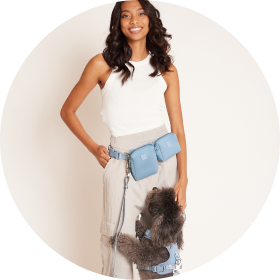- Home
- The Daily Wag!
- Senses
- Can Dogs Detect Mold?

Can dogs detect mold? They sure can! If you didn't already know, our doggos have an amazing sense of smell. That snoot of theirs is able to sniff out disease, missing people and yes, even mold. Dogs not only love us unconditionally, they can also be taught to sniff out mold.
There are actually mold detection dogs are specially trained for just this purpose. The best breeds for this job are normally Labs, Border Collies, Jack Russell Terriers, Aussies, Beagles, and mixes of these breeds. These dogs are trained to sniff out 18 different types of mold.
Mold is bad because it can make us sick, but because the mold detection dogs are not exposed to it for more than a few minutes at a time, it does not make them sick.
Compared to the trained pros that sniff out this stuff, our family dogs do not fare as well when they are exposed to mold for extended periods of time. Mold can be anywhere, inside and outside of a home, hiding beneath baseboards, window sills, and attic crawl spaces. Mold is easily inhaled or can be licked off of a surface by our doggies. Some mold is toxic and can cause respiratory difficulties, neurological issues and even death in both humans and dogs.
Never let your dog eat anything from the ground or sniff something for too long a period. If you aren't aware of mold issues inside and around your house and your dog begins experiencing breathing issues, keep an eye on them. If the coughing and sneezing are accompanied by your doggo acting confused or weakened, a trip to the vet may be in order and a home inspection may also be needed.
There are other ways you can detect mold allergies in your furry friends. If your dogs inhaled some mold spores they will experience some breathing issues, runny snoots, weakness and sometimes bleeding from their nose and mouth. If they ingest mold, your dog will have GI issues, loss of appetite, vomiting, and changes in their stools.
In the cases of mold allergies, your dog will be itching and scratching or licking and biting at their paws that can result in sores or loss of their fur in spots. Other types of molds attack the neurological system and cause seizures or damage your pet's organs. If any of these symptoms present themselves for longer than 24 hours, head to the vet immediately.
Body Language
Some signs that your dog is having an adverse reaction to mold include:
- Shaking
- Weakness
- Raspy Panting
- Lack Of Focus
- Whimpering
- Licking
- Sleepiness
Other Signs
Depending on the severity of mold exposure and the type of mold itself, your dog may exhibit symptoms as simple as sneezing to complex problems like neurological issues. If you notice your dog experiencing these symptoms in any combination, head to your vet for a check-up:
- Confusion
- Vomiting
- Loss Of Appetite
- Tremors Or Seizures
Mold often breeds in humid, damp places, so for as long as there have been humid, damp places, mold has been spreading its spores and bacterial growth from sea to shining sea.
A 1999 study at the Mayo Clinic found that over 37 million Americans developed sinus infections due to molds in their homes. A 1994 study by USA Weekend Magazine found that 50% of the 10,000 homes tested had water damage and nasty mold issues, which would ultimately lead to respiratory issues for their occupants. There have even been recent studies that show 20% of America's schools have faulty ventilation systems which result in poor indoor air quality for our kids.
Dogs only headed indoors relatively recently, having been used for farm work or hunting in previous centuries. Since they joined us inside the home, they have also been exposed to concentrated amounts of mold.
We love our fur-babies, but sometimes, let's just face it, they are gross. They eat, sniff or lick anything in front of them and that is why they get so sick so much.
When a pet comes in contact with mold, they will have the same reactions as us at first - sneezing, runny noses, asthma, itching, or congestion. When mold enters the body, it invades all of our systems, including lungs, blood, muscles, and organs. Mold exposure can also result in joint issues, fungal skin disorders, mobility problems, fatigue and depression and life-threatening diseases such as ringworm.
It is important to keep an eye on your furry pal when they are outdoors, especially at a dog park. Mold lies in wait on more surfaces than we can count - and a dog park - that is a mold family reunion. Keep your dog away from the garbage cans, wild mushrooms, other dog's fecal matter, standing water, or rotting tree stumps and oh yeah, do not throw that stick laying on the ground for them to fetch.
All it takes is one too many licks, sniffs or bites of rotting food, another dog's poop, or mystery mounds of yuck to be exposed and get sick.
A mold dog is trained for at least 1000 hours to get proficient in their task - to detect mold in homes, daycares, schools, hotels, and other structures. The dog is then coupled up with a trainer and they work as a mold detection team for at least 40 hours!
How are the dogs trained? The dogs are exposed to different species of mold through a controlled and safe test environment. When the dog hits the mark or finds the mold, they are rewarded. This continues over and over until the dog's accuracy is spot-on when detecting mold smells and spores. If the dogs ever display symptoms of mold allergies, no matter how slight, they are immediately treated and given time to recuperate.
Have questions or concerns about your pet?
Chat with a veterinary professional in the Wag! app 24/7.
Get Vet ChatSafety Tips When Dealing with Mold
- Wash your pet's toys and bedding often.
- Wash dog food and water bowls once a day and pitch plastic dishes.
- Keep your pet food in sealed containers.
- Keep your trash containers secured.
Written by a Smooth Coated Collie lover Mary Alane Whalen
Veterinary reviewed by:
Published: 02/28/2018, edited: 04/06/2020
More articles by Mary Alane Whalen

